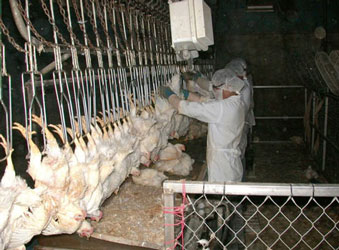AVMA releasing guidelines on humane slaughter
The AVMA has nearly completed guidelines on the humane slaughter of farmed food animals ranging from hoofed stock and poultry to fish, alligators, and rabbits.
On Jan. 10, the AVMA Executive Board approved the content of the first edition of the AVMA Guidelines for the Humane Slaughter of Animals. The draft version of the report runs more than 50,000 words.
Dr. Mark P. Helfat, District II representative, remarked that he spent the better part of an afternoon reading the document. He said the subject is not pleasant, but he expressed appreciation for the tremendous amount of research and expertise that went into the guidelines.

While updating the AVMA Guidelines for the Euthanasia of Animals, the Panel on Euthanasia recommended separating the issues of slaughter and depopulation from euthanasia. A nine-member Panel on Humane Slaughter, comprising eight members of the euthanasia panel plus an expert on religious slaughter, developed the slaughter guidelines with support from working groups comprising individuals with relevant research and practical experience. Members of the AVMA provided input during a comment period.
The report’s objective is to provide guidance for veterinarians who carry out or oversee animal slaughter on how to prevent pain and distress during the process. The scope of the report is the period from offloading of an animal at a slaughter facility until verification of the animal’s death.
The first edition covers the following farmed food animals: cattle, bison, horses and mules, sheep, goats, swine, deer, elk, chickens, turkey, pheasants, ratites, geese, ducks, fish, alligators, and rabbits. Dr. Gail C. Golab, director of the AVMA Animal Welfare Division, said future editions of the slaughter guidelines are likely to cover additional species—similar to the expansion of the euthanasia guidelines over the years.
The Panel on Humane Slaughter gave careful consideration to the following criteria in assessing the appropriateness of slaughter methods:
- Ability to induce loss of consciousness followed by death with a minimum of pain or distress.
- Time required to induce loss of consciousness and the behavior of the animal during that time.
- Reliability and irreversibility of the method resulting in death of the animal.
- Safety of personnel.
- Compatibility with intended animal use and purpose (i.e., meat consumption).
- Human outcomes, including potential psychological impacts on personnel and their effects on animal handling.
- Ability to maintain equipment in proper working order.
- Legal and religious requirements.
The next steps for the guidelines are a complete editorial review and copy editing as well as finalization of figures and construction of tables. The guidelines on depopulation are forthcoming.